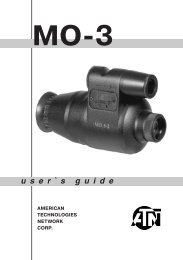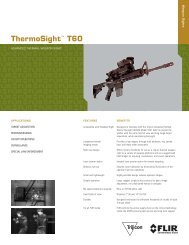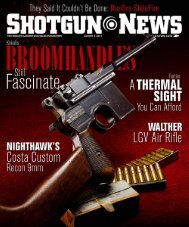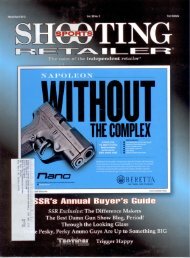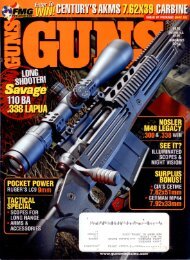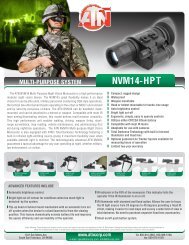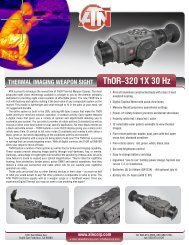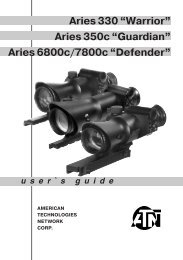Create successful ePaper yourself
Turn your PDF publications into a flip-book with our unique Google optimized e-Paper software.
THE<br />
NIGHT <strong>RAPTR</strong><br />
<strong>The</strong> most common response I get<br />
from unit commanders is that issuing<br />
patrolmen with some type of quality<br />
night vision device (NVD) is outside<br />
the department’s budget. And even if<br />
they had night vision scopes, could<br />
the image be dependable enough that<br />
an accurate, justifiable shot could be<br />
taken out to 100 yards? <strong>The</strong>se are the<br />
concerns I’ve determined to settle.<br />
THE ANSWER<br />
Having used the latest NVDs with good<br />
effect in the military, I usually write off<br />
1st Generation NVDs as archaic technology<br />
set in unwieldy heavyweight tubes<br />
that change the way a rifle handles. Besides<br />
that, they usually chew through<br />
my battery supply (often the type you<br />
can’t easily find). I’ve never considered<br />
putting my life or the lives of my teammates<br />
on the line for a 1st Generation<br />
optic, but <strong>ATN</strong> has changed that opinion.<br />
For the last several months, I’ve been<br />
working with <strong>ATN</strong>’s Aries MK 410. It<br />
is hands down the best 1st Generation<br />
night vision scope I’ve ever seen. It<br />
has the image quality comparable to a<br />
3rd Generation unit and reveals total<br />
darkness beyond the 100-yard distance<br />
I would recommend limiting an LE shot<br />
with night vision to. It has 5X magnification,<br />
a low F-stop and allows for<br />
more light to enter the objective, which<br />
improves resolution and provides a<br />
sharper image.<br />
<strong>The</strong> red Duplex target reticle is<br />
crisp and can be adjusted for brightness<br />
intensity on target. For shots<br />
made at ranges beyond 25 yards, I<br />
also encourage the use of<br />
<strong>ATN</strong>’s 450 mW IR illuminator<br />
that’s included with the unit<br />
and works in tandem. <strong>ATN</strong>’s<br />
logistical blessing is that it<br />
uses common CR123 lithium<br />
batteries, the same battery likely found<br />
in your Surefire. If the battery in the<br />
optic’s illuminator were to die, the light<br />
on the Crimson Trace MVF-515 vertical<br />
foregrip (which is also available as a<br />
covert IR illuminator) is an effective<br />
backup. <strong>The</strong> MVF-515’s laser is easily<br />
picked up and can be used in conjunction<br />
with the <strong>ATN</strong> MK 410 for closer<br />
shots. I haven’t had to concern myself<br />
with the scope crapping out on me due<br />
to batteries. One CR123 gives the scope<br />
20 hours of life.<br />
RANGE TIME<br />
Testing began in daylight hours to<br />
evaluate the DPMS <strong>RAPTR</strong>. I used a<br />
Specifications DPMS <strong>RAPTR</strong><br />
Caliber:<br />
5.56 NATO<br />
Action:<br />
Direct impingement,<br />
gas-operated semiautomatic<br />
Barrel Length: 16 in.<br />
Overall Length: 32.5 in. (collapsed),<br />
36.38 in. (extended)<br />
Weight:<br />
8.2 lb. (empty)<br />
Grip:<br />
Ergo Suregrip<br />
Stock:<br />
AP4, six-position, collapsible<br />
Magazine: Mil-Spec, 30-round<br />
Price: $1,649<br />
Manufacturer: DPMS, 800-578-3767,<br />
dpmsinc.com<br />
ACCURACy—dpms raptr<br />
DPMS <strong>RAPTR</strong> w/ Leupold Mark 4 LR/T 3.5-10x40mm<br />
LOAD BULLET VELOCITY AVG BEST<br />
WEIGHT (gr.) (fps) (in.) (in.)<br />
Federal Gold Medal 69 2,646 0.97 0.45<br />
DPMS <strong>RAPTR</strong> w/ <strong>ATN</strong> MK 410 5X<br />
LOAD BULLET VELOCITY AVG BEST<br />
WEIGHT (gr.) (fps) (in.) (in.)<br />
Federal Gold Medal 69 2,646 1.82 1.15<br />
Leupold Mark 4 3.5-10x40mm LR/T<br />
riflescope to extract the best possible<br />
performance from the rifle. And with<br />
it, I pulled off the best group I’ve ever<br />
shot with any non-match M4-style<br />
rifle. I couldn’t have done it without<br />
the consistency of Federal’s Gold<br />
Medal 69-grain loaded with Sierra’s<br />
MatchKing boattail hollowpoint. <strong>The</strong><br />
stars were aligned when I put five<br />
shots into two holes measuring .45<br />
inch center to center from the prone<br />
position on a Harris bipod. <strong>The</strong> average<br />
was a respectable .97 inch from<br />
100 yards.<br />
When darkness fell, I returned to<br />
the range and attached the <strong>ATN</strong> MK<br />
410. How much accuracy can you<br />
really expect to get out of a night<br />
vision-equipped rifle at 100 yards?<br />
Good question.<br />
I made the bad choice of ignoring<br />
<strong>ATN</strong>’s advice of sighting-in the unit<br />
during daylight hours and tuning it at<br />
night, which meant that I had to walk<br />
100 yards and kick up my heart rate to<br />
inspect the target after every three shots<br />
to determine an adjustment. After five<br />
trips downrange, I finally used what<br />
was left of my $25-a-box supply of Federal<br />
match ammunition to shoot four<br />
five-shot groups with the red Duplex<br />
reticle illuminated on the third setting.<br />
Shot after shot went through the rifle<br />
without incident, but I was frustrated<br />
with the anticipation of knowing where<br />
the shots were printing.<br />
Although I could clearly see each<br />
target diamond using the NVD’s focus<br />
knob, I couldn’t distinctly make out the<br />
intense neon-colored rings surrounding<br />
each bullet hole on the Shoot-N-C<br />
target. When the shooting was over, I<br />
had averaged 1.82 inches for all four<br />
*Hatchet not included<br />
146 book of the ar-15 |<br />
|<br />
book of the ar-15<br />
147




